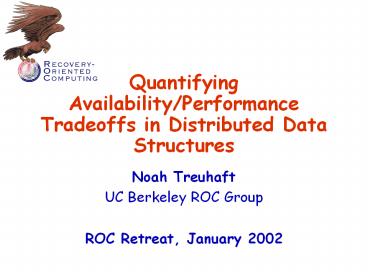Quantifying Availability/Performance Tradeoffs in Distributed Data Structures - PowerPoint PPT Presentation
Title:
Quantifying Availability/Performance Tradeoffs in Distributed Data Structures
Description:
... single-node hash table plus RPC skeletons for network access ... human operators to perform repairs. Repair Time. QoS degradation. failure. normal behavior ... – PowerPoint PPT presentation
Number of Views:88
Avg rating:3.0/5.0
Title: Quantifying Availability/Performance Tradeoffs in Distributed Data Structures
1
Quantifying Availability/Performance Tradeoffs in
Distributed Data Structures
- Noah Treuhaft
- UC Berkeley ROC Group
- ROC Retreat, January 2002
2
Outline
- Motivation
- Distributed data structures
- A shared-disk DB toolkit
- Quantifying the tradeoffs
- Status
3
Motivation
- Many interactions between availability and
performance in systems - some are synergies (DB index structure modifying
operations as nested top actions) - others are tradeoffs (transaction throughput)
- ROC principle availability is not subordinate to
performance - the application determines the appropriate
balance... - and that guides us through the tradeoffs
4
Motivation (2)
- Implication for systems research lead by
building tunable systems - but must ensure that people understand how to
tune them! - unlabeled knobs are useless
- Key insight quantify availability/performance
tradeoffs with availability benchmarking - hard work, so dont make system users do their
own benchmarking
5
Outline
- Motivation
- Distributed data structures
- A shared-disk DB toolkit
- Quantifying the tradeoffs
- Status
6
Whats a distributed data structure (DDS)?
- Interface like a centralized data structure
- uniform access from all cluster nodes
- Updates
- consistency model
- Persistent
- Out-of-core
- Building block for Internet-style services
- provides persistent state management
- high throughput AND high availability
- service inherits tradeoffs from DDS
7
Gribbles prototype DDS distributed hash table
clients interact with any service
front-end all persistent state is in DDS and
is consistent across cluster
client
client
client
client
client
service interacts with DDS via library library
is 2PC coordinator, handles partitioning,
replication, etc., and exports hash table API
brick is durable single-node hash table plus
RPC skeletons for network access
storage brick
storage brick
storage brick
example of a distributed HT partition with 3
replicas in group
storage brick
storage brick
storage brick
from a presentation by Steve Gribble
8
Outline
- Motivation
- Distributed data structures
- A shared-disk DB toolkit
- Quantifying the tradeoffs
- Status
9
Berkeley DB overview
- Great for persistent state management
- and more
- Access methods for unordered and ordered data
- hash table and B-tree
- Transactions
- Runs on a single machine
10
Berkeley DB architecture
11
Shared-disk DB architecture
Cluster node
12
Outline
- Motivation
- Distributed data structures
- A shared-disk DB toolkit
- Quantifying the tradeoffs
- Status
13
Two tradeoffs
- Concurrent intersystem page modification
- log merge required during recovery
- reduced page contention
- page transfers replaced by log-record transfers
- Hot page replication
- immediate page recovery
- reduced logging?
- memory overhead
- two-phase commit overhead
14
Availability benchmarking 101
- Availability benchmarks quantify system behavior
under failures, maintenance, recovery - They require
- a realistic workload for the system
- quality of service metrics and tools to measure
them - fault-injection to simulate failures
- human operators to perform repairs
normal behavior(99 conf.)
QoS degradation
failure
Repair Time
from a presentation by Dave Patterson
15
Outline
- Motivation
- Distributed data structures
- A shared-disk DB toolkit
- Quantifying the tradeoffs
- Status
16
Status
- Getting familiar with Berkeley DB
- implemented TPC-B
- looking through the source code
- Combing through shared-disk DB research
literature - Identifying availability/performance tradeoffs
- others will appear during implementation































